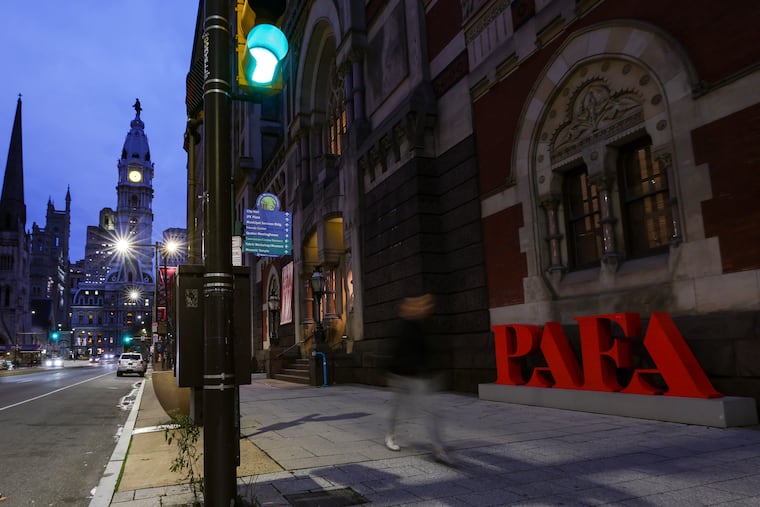What is PAFA and what’s going on there?
Why is the Pennsylvania Academy of Fine Arts ending its degree program?

Wednesday, the Pennsylvania Academy of the Fine Arts announced that it’s ending its degree program, which has raised many questions. Here’s what we know.
What is PAFA?
PAFA, founded in 1805, is the nation’s first institution that is both an art museum and school. It has long offered undergraduate and graduate degrees in fine arts, educating some of the most prominent artists in Philadelphia and around the country. The museum, best known for its extensive collection of 19th- and 20th-century American art, hosts exhibits year-round. PAFA’s original building at Broad and Cherry Streets, designed by Frank Furness and George W. Hewitt, is a National Historic Landmark.
Art training has been part of PAFA’s mission since its founding at 10th and Chestnut St. at the beginning of the 19th century, but it was Philadelphia painter Thomas Eakins who formalized the school’s educational program in the 1880s with a “sequentially organized program of elementary and advanced courses outlined in a printed catalog,” according to a PAFA history. A small tuition was introduced.
In 1929, PAFA began offering a bachelor’s degree in partnership with the University of Pennsylvania. In 1991, PAFA opened its graduate school, offering a master of fine arts degree, and, in 2008, it launched a bachelor of fine arts degree program separate from the one offered with Penn.
What is happening with PAFA now?
PAFA is winding down its degree-granting programs. Its bachelor’s and master’s degree programs will be ended at the completion of the 2024-25 school year, school officials said.
The Academy will keep its museum open and fully operating, and plans to carry on continuing education and K-12 arts programs.
At the same time, PAFA intends to restore its comprehensive three- or four-year certificate program and relaunch it this fall. The program, from which many artists graduated over a period of decades, was dropped in 2017.
“Our new blueprint for the future will tap the best of PAFA’s history and marry it to a future vision that is wholly unique, appealing to a broad art community, and financially sustainable,” Anne McCollum, chair of PAFA’s board, said in a press statement.
Why is PAFA ending its degree programs?
PAFA is currently running a $3 million annual deficit, and ending its degree programs is expected to save a little more than $1 million. It will open up some space in the school’s Hamilton building, which PAFA hopes to rent out, bringing in some new revenue. Leaders hope that those two changes along with some others will close the budget gap.
PAFA has raised tens of millions of dollars in recent years for building renovations, but PAFA president Eric G. Pryor said it didn’t make sense to raise funds to save the degree programs due to a trend of declining student enrollment.
Enrollment has dropped by half — from 270 students in 2019 to 126 in 2023 — while costs have increased, according to figures provided by school officials. In fiscal year 2023, the school incurred a loss of $7,090 per student, compared with fiscal year 2017, when it showed a gain of $6,322 per student.
What will happen to the existing PAFA students?
MFA students expecting to graduate from PAFA in 2024 or 2025 will still be able to do so, the school said.
Freshmen and sophomores will have to enroll elsewhere at the end of the current academic year. PAFA said it has 37 such students.
“We will create personalized transfer plans to a range of local and well-regarded schools with whom we have made agreements so that students can complete their arts degrees with minimal disruption,” wrote Pryor in a statement addressed to members of the PAFA community.
Agreements are in place with University of the Arts, Temple University’s Tyler School of Art and Architecture, Moore College of Art & Design, Arcadia University, and Pennsylvania College of Art and Design, his statement said.
What’s the difference between a degree and a certificate program?
The bachelor of fine arts was a four-year program that combined studio work with a traditional liberal arts education, and the masters of fine arts was a graduate-level two-year program, with a competitive application process and the requirement that students already had a college degree. The certificate program as it existed was not age-specific, and taught the foundations of art, without a required core curriculum of traditional academic subjects.
What will happen to PAFA faculty?
PAFA currently has 21 full-time and 21 part-time faculty members, a spokesperson said, and although they will be retained for now, no firm plan exists yet for their employment after the degree programs are phased out. The number of faculty who will be retained will depend on how many students enroll in the restored certificate program, Pryor said.
Who are its notable alums?
“Almost every American artist of note has been collected and exhibited by PAFA or has taught here. PAFA has always provided world-class fine arts education and will continue to do so,” McCollum said. The school’s illustrious alumni include Mary Cassatt, Maxfield Parrish, David Lynch, Alexander Milne Calder, Barkley L. Hendricks, and generations of boundary-pushing, radical artists.
Staff writer Zoe Greenberg contributed to this article.